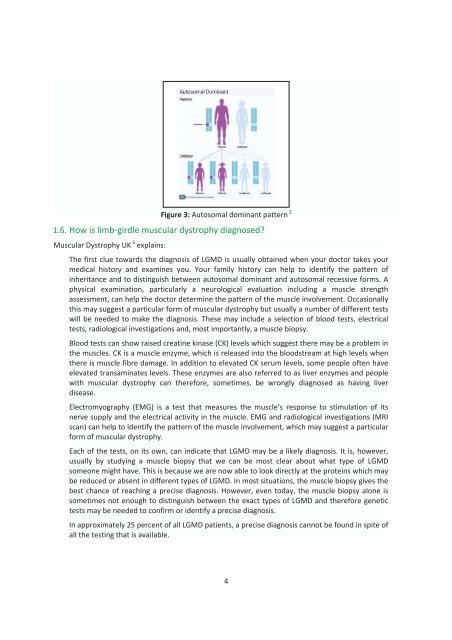Create successful ePaper yourself
Turn your PDF publications into a flip-book with our unique Google optimized e-Paper software.
Figure 3: Autosomal dominant pattern 2<br />
1.6. How is limb-girdle muscular dystrophy diagnosed?<br />
Muscular Dystrophy UK 3 explains:<br />
The first clue towards the diagnosis of <strong>LGMD</strong> is usually obtained when your doctor takes your<br />
medical history and examines you. Your family history can help to identify the pattern of<br />
inheritance and to distinguish between autosomal dominant and autosomal recessive forms. A<br />
physical examination, particularly a neurological evaluation including a muscle strength<br />
assessment, can help the doctor determine the pattern of the muscle involvement. Occasionally<br />
this may suggest a particular form of muscular dystrophy but usually a number of different tests<br />
will be needed to make the diagnosis. These may include a selection of blood tests, electrical<br />
tests, radiological investigations and, most importantly, a muscle biopsy.<br />
Blood tests can show raised creatine kinase (CK) levels which suggest there may be a problem in<br />
the muscles. CK is a muscle enzyme, which is released into the bloodstream at high levels when<br />
there is muscle fibre damage. In addition to elevated CK serum levels, some people often have<br />
elevated transaminates levels. These enzymes are also referred to as liver enzymes and people<br />
with muscular dystrophy can therefore, sometimes, be wrongly diagnosed as having liver<br />
disease.<br />
Electromyography (EMG) is a test that measures the muscle’s response to stimulation of its<br />
nerve supply and the electrical activity in the muscle. EMG and radiological investigations (MRI<br />
scan) can help to identify the pattern of the muscle involvement, which may suggest a particular<br />
form of muscular dystrophy.<br />
Each of the tests, on its own, can indicate that <strong>LGMD</strong> may be a likely diagnosis. It is, however,<br />
usually by studying a muscle biopsy that we can be most clear about what type of <strong>LGMD</strong><br />
someone might have. This is because we are now able to look directly at the proteins which may<br />
be reduced or absent in different types of <strong>LGMD</strong>. In most situations, the muscle biopsy gives the<br />
best chance of reaching a precise diagnosis. However, even today, the muscle biopsy alone is<br />
sometimes not enough to distinguish between the exact types of <strong>LGMD</strong> and therefore genetic<br />
tests may be needed to confirm or identify a precise diagnosis.<br />
In approximately 25 percent of all <strong>LGMD</strong> patients, a precise diagnosis cannot be found in spite of<br />
all the testing that is available.<br />
4

















